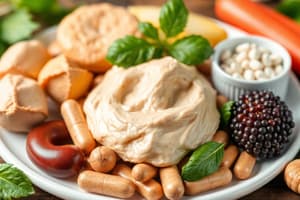Podcast
Questions and Answers
Which of the following dairy servings is equal to 1 cup of milk? (Select all that apply)
Which of the following dairy servings is equal to 1 cup of milk? (Select all that apply)
- 2 ounces of processed cheese
- 1 cup of yogurt (correct)
- C and D (correct)
- None of the above
What is a protein equivalent to 1 ounce of meat or poultry?
What is a protein equivalent to 1 ounce of meat or poultry?
1/4 cup of cooked beans
Foods that are considered complete proteins include: (Select all that apply)
Foods that are considered complete proteins include: (Select all that apply)
- Meat, fish, and poultry
- Dairy products
- Quinoa seeds and chia seeds
- Eggs
- All of the above (correct)
What is true regarding protein? (Select all that apply)
What is true regarding protein? (Select all that apply)
What is true regarding proteins and amino acids? (Select all that apply)
What is true regarding proteins and amino acids? (Select all that apply)
This process of breaking down molecules releases energy.
This process of breaking down molecules releases energy.
What is the process the body uses to obtain or make energy from the food eaten?
What is the process the body uses to obtain or make energy from the food eaten?
What unit measures how much energy is in a particular food?
What unit measures how much energy is in a particular food?
What statement is incorrect regarding glycogen?
What statement is incorrect regarding glycogen?
Which of the following foods would be a smart carbohydrate choice?
Which of the following foods would be a smart carbohydrate choice?
Which of the following is not a nutrient-rich carbohydrate?
Which of the following is not a nutrient-rich carbohydrate?
Which of the following is not a complex carbohydrate?
Which of the following is not a complex carbohydrate?
Which of the following does not contain a significant source of fiber?
Which of the following does not contain a significant source of fiber?
What statement is incorrect regarding fiber?
What statement is incorrect regarding fiber?
What is incorrect regarding the glycemic index (GI)?
What is incorrect regarding the glycemic index (GI)?
Which nutrient has 9 kcal/g?
Which nutrient has 9 kcal/g?
What is true regarding fat? (Select all that apply)
What is true regarding fat? (Select all that apply)
Triglycerides (Select all that apply)
Triglycerides (Select all that apply)
Which of the following contains saturated fats?
Which of the following contains saturated fats?
Which statement is correct regarding trans fatty acids?
Which statement is correct regarding trans fatty acids?
Cholesterol is: (Select all that apply)
Cholesterol is: (Select all that apply)
Minerals found in body fluids are called?
Minerals found in body fluids are called?
What is true regarding minerals? (Select all that apply)
What is true regarding minerals? (Select all that apply)
Which is not an antioxidant?
Which is not an antioxidant?
Which is not fat-soluble?
Which is not fat-soluble?
Vitamin C can be found in: (Select all that apply)
Vitamin C can be found in: (Select all that apply)
Vitamin D can be found in: (Select all that apply)
Vitamin D can be found in: (Select all that apply)
A deficiency in Vitamin A causes?
A deficiency in Vitamin A causes?
A deficiency in Vitamin K causes?
A deficiency in Vitamin K causes?
A deficiency in Vitamin C causes?
A deficiency in Vitamin C causes?
Water: (Select all that apply)
Water: (Select all that apply)
Water needs increase: (Select all that apply)
Water needs increase: (Select all that apply)
Dietary supplements: (Select all that apply)
Dietary supplements: (Select all that apply)
MyPlate dietary guidelines include: (Select all that apply)
MyPlate dietary guidelines include: (Select all that apply)
What foods would not be found on a clear liquid diet?
What foods would not be found on a clear liquid diet?
What food would not be found on a full liquid diet?
What food would not be found on a full liquid diet?
A soft diet is used for: (Select all that apply)
A soft diet is used for: (Select all that apply)
What is true regarding weight control diets? (Select all that apply)
What is true regarding weight control diets? (Select all that apply)
What condition requires monitoring carbohydrate intake?
What condition requires monitoring carbohydrate intake?
What condition requires monitoring calorie intake and portion sizes?
What condition requires monitoring calorie intake and portion sizes?
What condition would require the use of the Glycemic index, the 'Create Your Plate' method, or carb counting?
What condition would require the use of the Glycemic index, the 'Create Your Plate' method, or carb counting?
What condition would require the use of a low sodium diet?
What condition would require the use of a low sodium diet?
John has hypertension, what foods should he limit? (Select all that apply)
John has hypertension, what foods should he limit? (Select all that apply)
DASH is used for what condition?
DASH is used for what condition?
Sam is on a low protein diet for liver disease. What foods should he limit?
Sam is on a low protein diet for liver disease. What foods should he limit?
What is true regarding food allergies? (Select all that apply)
What is true regarding food allergies? (Select all that apply)
A gluten-free diet is used for what condition?
A gluten-free diet is used for what condition?
What foods would not be found on a gluten-free diet? (Select all that apply)
What foods would not be found on a gluten-free diet? (Select all that apply)
What is true regarding lactose sensitivity? (Select all that apply)
What is true regarding lactose sensitivity? (Select all that apply)
For patients undergoing cancer treatments, what is encouraged? (Select all that apply)
For patients undergoing cancer treatments, what is encouraged? (Select all that apply)
What changes might a person have who is undergoing cancer treatment? (Select all that apply)
What changes might a person have who is undergoing cancer treatment? (Select all that apply)
This condition is a psychiatric eating disorder that causes people to lose more weight than what is healthy.
This condition is a psychiatric eating disorder that causes people to lose more weight than what is healthy.
This condition causes overeating that leads to self-disgust and may involve vomiting, laxative use, and excessive exercise.
This condition causes overeating that leads to self-disgust and may involve vomiting, laxative use, and excessive exercise.
Flashcards are hidden until you start studying
Study Notes
Dairy Servings
- 1 cup of milk is equivalent to 2 ounces of processed cheese or 1 cup of yogurt.
Protein Equivalents
- 1 ounce of meat or poultry is equivalent to 1/4 cup of cooked beans.
Complete Proteins
- Complete proteins include meat, fish, poultry, dairy, quinoa, chia seeds, and eggs.
Role of Proteins
- Proteins break down into amino acids and are crucial for tissue growth, repair, and energy production in the absence of carbohydrates.
Amino Acids
- Essential amino acids are not produced by the body, while conditional amino acids are essential during illness. Nonessential amino acids are synthesized by the body, and complete proteins contain all essential amino acids.
Metabolism Terms
- Catabolism refers to the breakdown of molecules into smaller units with energy release.
- Metabolism encompasses all processes for converting food into energy.
Energy Measurement
- Caloric content measures how much energy food provides, with fat providing 9 kcal/g.
Carbohydrates
- Smart carbohydrate choices include low-fat milk, while honey is not a nutrient-rich carbohydrate. Nuts and seeds are classified as non-complex carbohydrates.
Dietary Fiber
- Yogurt does not provide significant fiber, and soluble fiber is incorrectly stated to be found in nuts, prunes, and popcorn.
Glycemic Index (GI)
- High GI foods produce variable changes in blood glucose levels and can aid in weight loss efforts.
Dietary Fats
- Different types of fats include saturated (found in butter, cheese, and whole milk) and trans fatty acids, which raise LDL cholesterol levels.
Cholesterol Facts
- Cholesterol is found in animal products, produced by the liver, and essential for cell membrane structure and hormone synthesis.
Minerals and Their Roles
- Essential minerals include calcium for teeth and bones, potassium and sodium for muscle and nerve function, iron for metabolism, and iodine for thyroid function.
Vitamins Overview
- Vitamin K is not an antioxidant, while Vitamin C (found in citrus and green vegetables) and Vitamin D (found in fatty fish and fortified milk) are essential vitamins.
- Deficiencies in Vitamins A, K, and C lead to night blindness, bleeding, and scurvy, respectively.
Importance of Water
- Water maintains body temperature, lubricates joints, and needs increase in hot weather, during activity, and in illness.
Dietary Supplements
- Include vitamins, minerals, amino acids, and herbs to address nutrient deficiencies.
MyPlate Guidelines
- Recommendations include filling half the plate with fruits and vegetables, choosing whole grains, and limiting saturated fats and added sugars.
Diets and Health Conditions
- Clear liquid diets exclude juice with pulp, while full liquid diets exclude chunky soups.
- Soft diets address chewing and swallowing difficulties.
Weight Control
- A daily reduction of 500-1000 calories leads to a weight loss of 1-2 pounds per week.
- Monitoring carbohydrates is crucial for managing diabetes, while calorie intake is vital for weight control.
Dietary Considerations
- A low sodium diet is necessary for conditions like hypertension and cardiovascular disease.
- Foods high in sodium, such as bacon and frozen meals, should be limited for individuals with hypertension.
Dietary Approaches
- DASH diet is specifically aimed at reducing cardiovascular risks.
- Low protein diets are recommended for liver disease management.
Food Allergies
- Common allergens include milk, eggs, and nuts; they can trigger severe reactions like anaphylaxis. An elimination diet may be necessary.
Celiac Disease
- A gluten-free diet is required for managing celiac disease, excluding foods such as whole-wheat bread and barley.
Lactose Sensitivity
- Treatment focuses on avoiding dairy products or using enzyme replacements.
Cancer Treatment Nutrition
- Patients are encouraged to maintain a soft, bland diet, consume high-protein and calorie-dense meals, drink liquids between meals, and limit irritants like caffeine and alcohol.
Impact of Cancer Treatment
- Side effects can include mouth sores, changes in taste, dry mouth, and nausea, complicating dietary intake.
Eating Disorders
- Anorexia nervosa is characterized by extreme weight loss due to restrictive eating, while bulimia nervosa involves episodes of overeating followed by purging behaviors.
Studying That Suits You
Use AI to generate personalized quizzes and flashcards to suit your learning preferences.




